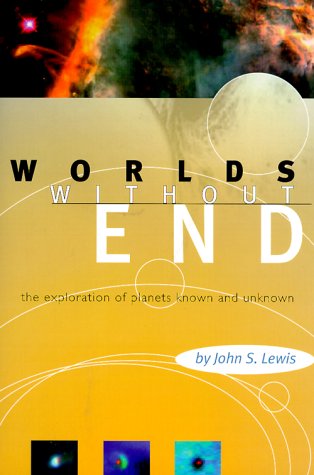

| WORLDS WITHOUT END John S. Lewis New York: Perseus Books, 1998 |
Rating: 5.0 High |
|||
| ISBN-13 978-0-7382-0011-8 | ||||
| ISBN 0-7382-0011-5 | 236pp. | HC/BWI | $24.00 | |
In his newest book, Dr. Lewis attempts to impart his considerable knowledge, acquired over the course of some 30 years, about how stars and planets form. The attempt is largely successful, due to his clear and breezy style and the fact that the text avoids the quantitative side of the topic for the most part. (And, believe you me, planetology is a science where the quantitative side of things matters a lot.)
I don't mean that the text is devoid of numbers; just that it does not overwhelm the casual reader — its intended audience — with them. You will encounter the ratios for orbital resonances (or tidal locks), for example. It is a tidal lock that keeps one face of the moon pointed toward Earth (a 1:1 resonance) and Mercury is locked into a 3:2 resonance with the nearby Sun. Temperatures appear frequently, as do distances (mostly given in Astronomical Units, or AU.) Technical terms and symbols are common as well; the terms are explained in the glossary. Perhaps the most difficult material is in Chapter 17, where Dr. Lewis examines possible alternative bases for biochemistry different from what we know on this watery planet. Here also is the most convincing explanation I've yet seen of why silicon-based life forms are not likely to exist.
A customary feature of Dr. Lewis' popular books is a review of the history of the subjects, and here the reader will find a history of cosmology as understood from the early Greek Atomists and the writers of Judeo-Christian scripture through 20th-century science fiction and fact. The survey is interesting; but it could have been omitted without detracting from the quality of the book. There were several places where I found myself wishing for more explanation of planetary science.
Of errors, the book is admirably free. I detected two grammatical mistakes and one possible technical error, and a minor one at that.
| Page 86: | "Based on our experience on earth, identifying Mars' Tharsis Ridge volcanoes as magma extrusion from a crack seems less likely than a single hot spot in the Martian mantle, a plume of hot, rising magma, has slowly worked its way along the base of the Martian lithosphere, sequentially generating the giant volcanoes." |
| This should read "less likely than if a single hot spot". |
| Page 90: | "Attempts to cool down the surface of a body of pure water cools the whole lake ..." |
| Subject-verb number disagreement: should read "Attempts ... cool". |
| Page 130: | Page 130 describes the intense radiation found in Jupiter's vicinity as "million-volt particles". |
| The proper term is "million-electron-volt particles" or "million-eV particles". This could be a technical error, but probably is a typo. |

 To contact Chris Winter, send email to this address.
To contact Chris Winter, send email to this address.